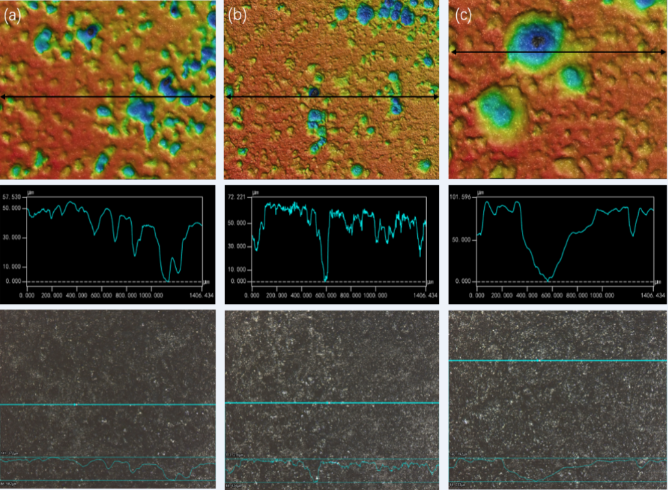
金属焊接-图6-耐蚀钢CRS-3在达叻现场腐蚀1年后的表面轮廓(a)母材,(b)热影响区,(c)焊缝.。通过CO2气体保护焊(250A, 29V, 300mm/min, 14.5 kJ/cm)。
耐蚀钢CRS-3焊接接头母材、熔合线和焊缝区均受到不同程度的腐蚀,表面布满了大大小小的点蚀坑。其中,母材位置的点蚀坑比较多,但是比较浅,最深处仅有56μm。熔合区和焊缝区的点蚀坑深度逐渐变大,焊缝区点蚀坑最大直径可达450μm,深度可达101μm。说明母材比焊缝耐蚀性要好。对于2年现场腐蚀试样,可以看出焊缝区与母材区腐蚀程度基本一致,同时热影响区出现腐蚀不均匀的情况。
Metal welding - Figure 6 - surface profile of corrosion resistant steel crs-3 after 1 year corrosion at Dalat site (a) base metal, (b) heat affected zone, (c) weld. Through CO2 gas shielded welding (250A, 29V, 300mm / min, 14.5 kJ / cm).
The base metal, fusion line and weld zone of crs-3 welded joint are corroded to different degrees, and the surface is covered with pitting corrosion pits. Among them, there are many pitting pits in the base metal, but they are shallow, and the deepest pit is only 56 μ m。 The depth of pitting pits in fusion zone and weld zone increases gradually, and the maximum diameter of pitting pits in weld zone can reach 450 μ m. The depth can reach 101 μ m。 It shows that the corrosion resistance of base metal is better than that of weld metal. For the two-year field corrosion samples, it can be seen that the corrosion degree of the weld zone is basically the same as that of the base metal zone, and the corrosion is uneven in the heat affected zone.